From Footlight to Spotlight
Who’s ready for Year 3 in the fascinating quarter series? With 10 designs to date, and another five rolling out this year, let’s take a look the talented designers and sculptors who are giving women’s history a fresh, new look on U.S. money.
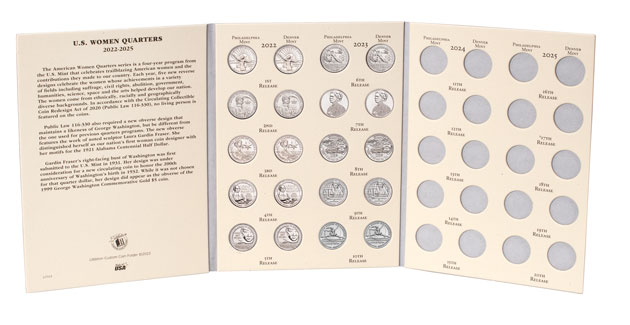
The Neo Renaissance
But first, the quick back story for those new to collecting. The renaissance occurred in 1907 when President Theodore Roosevelt demanded new coin designs. This revival had various spurts through 1921, according to notable reference books on the 20th century renaissance by numismatist and author Roger W. Burdette.
Then came a long period of stagnation that seeped into the new century. Yet, under the general public’s radar, a Neo Renaissance was percolating. In the fall of 2003, the U.S. Mint unveiled the Artistic Infusion Program (AIP). Qualifying artists submit competitive designs in the two-step process. They’re expected to “…bring innovative perspectives and utilize symbolism in their work to clearly and evocatively convey subjects and themes.”
“From portraits and landscapes to depictions of notable achievements in American history, coin and medal designs require rendering a range of subjects and themes on a small space,” according to the Mint’s website. The call for new talent is periodically renewed.
But the Mint didn’t stop there. It opened the design competition to its own medallic artists, a term applied to its sculptors who shape the designs into the models required to press coins and medals. Sculptor Joseph Menna was the first medallic artist hired in 2005. Menna came with both clay and digital skills. Two years later, the Mint unveiled the world’s first digitally sculpted coin, Menna’s obverse for the James Monroe Presidential dollar.
In 2019, Menna became the Mint’s 13th chief engraver. He succeeded John Mercanti, the last traditional engraver-designer. Mercanti racked up more than 100 coin designs during his nearly 40-year stint at the Philadelphia Mint, including the U.S. eagle shield on the American Silver Eagle dollar.
Menna was tasked with overseeing the implementation of the new sculptural technology. Equally important, he was given the responsibility to manage the partnership between the Mint’s medallic artists and the growing list of AIP designers. Their combined goal is a final design with no striking or metal flow problems. Menna also found the time to work on new designs.
The 2024 Women Quarters
On July 20, 2023, the Mint revealed Year 3’s motifs for release in 2024. “These beautiful designs recognize the achievements of these extraordinary women,” said Mint Director Ventris C. Gibson in a prepared statement, “and add to the Mint’s rich history of telling our Nation’s story through enduring examples of numismatic art.”
The women are:
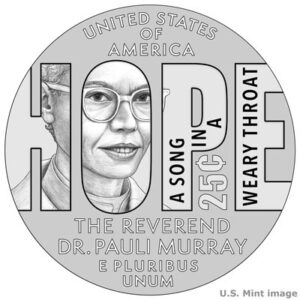
Rev. Dr. Pauli Murray – scheduled to be 11th quarter in the series, her masters’ dissertation for a law degree lead to the eventual publication of a 776-page compilation of mandated segregation across the U.S. in 1950. It became known as “the bible” of the Civil Rights Movement. Pauli also earned a PhD in jurisprudence from Yale University, qualifying her to teach law, the first African American woman to receive the degree from the Ivy League School. An accomplished poet, “Dark Testament,” her compilation of poems, was published in 1970. Her final career achievement was ordination as an Episcopal priest at the National Cathedral in Washington, D.C. She was the first African American woman to be ordained.
For science illustrator Emily Damstra, Pauli’s quarter is her fourth design in the series to date. It uses a number of symbols associated with Pauli’s achievements, including the word “hope” from Verse 8 of “Dark Testament”. It was Mint chief Menna who sculpted Damstra’s design. He was also the designer and sculptor of the Hubble Space Telescope for Maryland’s Innovation dollar.

Patsy Mink – With her 1964 election to the U.S. House of Representatives as the first woman of color, Patsy fought for racial and gender equity. The Japanese-American, Hawaii-born lawyer’s most enduring success was the 1972 passage of Title IX that prohibits sex discrimination (including pregnancy, sexual orientation, and gender identity) in any education program or activity receiving federal funds.
New to AIP is paleo-artist Beth Zaiken, who designed the 2023 Ohio Innovation dollar honoring the Underground Railroad. Medallic artist John P. McGraw sculpted Zaiken’s design for the coin press. In 2023, he was both the designer and sculptor of the intricate Jovita Idar quarter.
“What’s great is the learning experience,” McGraw said for the magazine of his alma mater, Rutgers University. “You come to…learn about the power and energy of someone like Jovita Idar…[and you] get to champion the voices of people whom a lot of people don’t know about.”
Another Double Talent
This year, two women quarters were designed and sculpted by Phebe Hemphill who’s been at the mint since 2006. In her impressive portfolio is the William McKinley Presidential dollar; the Shenandoah National Park quarter, and the Native American dollar honoring the woman who successfully championed passage of the nation’s first Anti-Discrimination Law in 1945, Elizabeth Peratrovich.
“My grandfather was a big influence on me,” Hemphill shared in an interview. “When I was young, he was collecting medals and was practicing bas-relief sculpture.”
And, thanks to a great grand aunt who was a student of Augustus Saint-Gaudens, Hemphill grew up admiring not only his works, but that of another classic American sculptor-turned-coin-designer, A. A. Weinman. Hemphill designed and sculpted the quarters that pay tribute to:
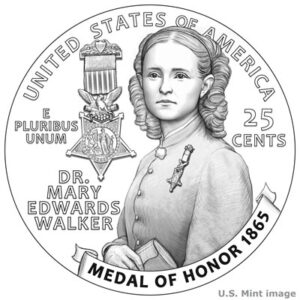
Dr. Mary Edwards Walker – was the first woman to earn a medical degree in surgery and the first – and to date the only – woman awarded a U.S. Medal of Honor. Raised on a farm in upstate New York, Mary’s parents, who were abolitionists, saw to it that their daughters received the same level of education as their one son. Mary’s mother also encouraged her daughters to wear bloomers to make farm work easier, a decision which would determine Mary’s clothing preference for the rest of her life.
With the 1861 outbreak of the Civil War, Mary volunteered to serve. After spending two years as a nurse treating the wounded in the nation’s capital and nearby Virginia, she was elevated to Army surgeon in Ohio. That achievement would earn her a Medal of Honor that she would proudly wear for the rest of her life.
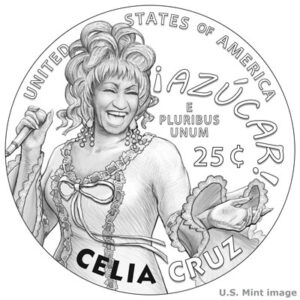
Celia Cruz – was one of the most popular Latin artists of the 20th century. Known as “The Queen of Salsa,” the Afro-Cuban-born, naturalized U.S. citizen fled the revolution and restarted her singing career in New York City. There, she evolved an electrifying musical style that blended guaracha, rumba, afro, son and bolero, with some New York jazz riffs. Her exuberant performances included lavish costumes, wigs, excessively high heels, and the shout of “Azucar!” – the Spanish word for sugar, part of the Cuban coffee culture that doubled as a verbal symbol of Celia’s love of life, her community and her heritage.
The Series’ Indigenous Women
Collectors of Native American coinage could easily make a subset of just those honored on quarters. In Year 1 was the Cherokee Nation’s first woman chief, Wilma Mankiller. In Year 2 it was Osage and prima ballerina Maria Tallchief. In Year 3, it is a member of the Yankton Tribe of South Dakota.
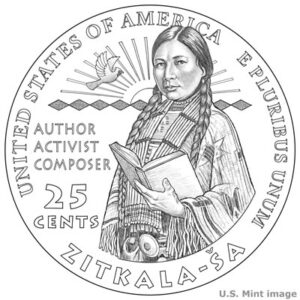
Zitkála-Šá (“Red Bird”) – was sent to an out-of-state missionary boarding school and renamed Gertrude Simmons. In her 1895 high school graduation speech, she advocated for women’s rights. Her fight for citizenship and voting rights for not only women, but all Indigenous people, was lifelong. In 1926, Zitkála-Šá co-founded the National Council of American Indians to advocate for better educational opportunities and health care, plus cultural recognition and preservation. Her writing credit for The Sun Dance Opera in 1913 was a first for Native Americans.
Hers is the 15th quarter in the series. It was designed by Don Everhart, whose other quarter was the Eleanor Roosvelt reverse. From 2004 to 2017, when he was a U.S. Mint Medallic Artist, Everhart sculpted the Statue of Liberty reverse for the Presidential Dollar series when it debuted in 2007 and later the Millard Fillmore Presidential dollar obverse in 2010.
Zitkála-Šá was sculpted by Medallic Artist Renata Gordon, who also molded the Edith Kanaka’ole quarter. In the U.S. Innovation series dollars to date, she sculpted the inaugural one featuring George Washington’s signature on the first-ever patent issued for potash, plus the Gerber Scientific Scale for Connecticut.
“I don’t remember not being an artist. I drew a lot, and I sculpted little things out of clay. I’ve always known [art would be my profession],” she revealed in 2019. “I was a sculpture major in college but I also drew a lot, so I really think I struck gold with this job—pun unintended…
“I probably speak for the rest of the artists when I say that before I start I just look at the image hard. I really look at it with a discerning eye to see what a drawing would look like in relief sculpture.”
Want to subscribe to Littleton Coin’s Heads & Tails blog? Sign up here, and have fun with your discoveries!
SOURCES:
Bowers, Q. David. “N.H. quarter’s designer describes artistic path.” March 20, 2013 https://www.coinworld.com/news/us-coins/n-h-quarters-designer-describes-artistic-path.html
Hay, Tina. “John P. McGraw Designs Unique Coins.” Rutgers Magazine. January 13, 2023. Accessed October 4, 2023. https://www.rutgers.edu/magazine/winter-2023/john-p-mcgraw-designs-unique-coins
“Don Everhart: My Career in Coins.” April 3, 2018. https://coinweek.com/don-everhart-my-career-in-coins-part-1-the-franklin-mint/ accessed October 4, 2023 (others on October 3, 2023
Unser, Mike. “US Mint Artists at Philadelphia Sculpt Digitally and in Clay.” September 6, 2013 CoinNews https://www.coinnews.net/2013/09/06/us-mint-artists-at-philadelphia-sculpt-digitally-and-in-clay/
CoinWeek IQ Coin Designer’s Profile: Phebe Hemphill. August 26, 2015 https://coinweek.com/coinweek-coin-designers-profile-phebe-hemphill/
Beete, Paulette. “First Person with U.S. Mint Medallic Artist Renata Gordon.” November 22, 2019. https://www.arts.gov/stories/blog/2019/first-person-us-mint-medallic-artist-renata-gordon
Gilkes, Paul. “Menna humbled by naming as chief Mint engraver.” February 8, 2019. https://www.coinworld.com/news/us-coins/menna-humbled-by-naming-as-chief-mint-engraver.html
Homren, Wayne. “John Mercanti Elevated to Head of U.S. Mint Engraving Department.” The E-Sylum: Volume 9, Number 22, May 28, 2006, Article 2. The Numismatic Bibliomania Society. Accessed October 4, 2023 https://www.coinbooks.org/esylum_v09n22a02.html



